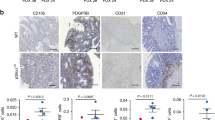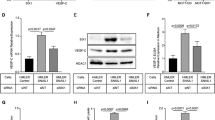Abstract
Ets-1 is the prototype of the family of ETS transcription factors. In human tumors, Ets-1 is expressed in endothelial cells and fibroblasts of the tumor stroma and is proposed to play a role in tumor vascularization and invasion by upregulating expression of matrix-degrading proteases. In human carcinomas, Ets-1 is also expressed by neoplastic cells, but little is known about the functional implications of this observation. We have addressed the role of Ets-1 in epithelial HeLa tumor cells by selecting stably Ets-1 over and underexpressing HeLa cells. Ets-1 expression increases the transformed phenotype of HeLa cells, by promoting cell migration, invasion and anchorage-independent growth, while Ets-1 downregulation reduces cell attachment. In correlation with these results, Ets-1 upregulation increases integrinβ2 expression but not that of other integrins. These results suggest that, in addition to its role in the tumor stroma, Ets-1 may also promote tumor development and progression by increasing neoplastic transformation.
This is a preview of subscription content, access via your institution
Access options
Subscribe to this journal
Receive 50 print issues and online access
$259.00 per year
only $5.18 per issue
Buy this article
- Purchase on Springer Link
- Instant access to full article PDF
Prices may be subject to local taxes which are calculated during checkout




Similar content being viewed by others
References
Adam M, Schmidt D, Wardelmann E, Wernert N and Albers P . (2003). Eur. Urol., 44, 329–336.
Adriaenssens E, Lottin S, Berteaux N, Hornez L, Fauquette W, Fafeur V, Peyrat JP, Le Bourhis X, Hondermarck H, Coll J, Dugimont T and Curgy JJ . (2002). Exp. Cell Res., 275, 215–229.
Baker KM, Wei G, Schaffner AE and Ostrowski MC . (2003). J. Biol. Chem., 278, 17876–17884.
Behrens P, Mathiak M, Mangold E, Kirdorf S, Wellmann A, Fogt F, Rothe M, Florin A and Wernert N . (2003). Int. J. Cancer, 107, 183–188.
Behrens P, Rothe M, Wellmann A, Krischler J and Wernert N . (2001). J. Pathol., 194, 43–50.
Block KL, Shou Y and Poncz M . (1996). Blood, 88, 2071–2080.
Bottinger EP, Shelley CS, Farokhzad OC and Arnaout MA . (1994). Mol. Cell. Biol., 14, 2604–2615.
Bradford AP, Wasylyk C, Wasylyk B and Gutierrez-Hartmann A . (1997). Mol. Cell. Biol., 17, 1065–1074.
Danen EH and Yamada KM . (2001). J. Cell. Physiol., 189, 1–13.
Dittmer J . (2003). Mol. Cancer, 2, 29.
Fafeur V, Tulasne D, Queva C, Vercamer C, Dimster V, Mattot V, Stehelin D, Desbiens X and Vandenbunder B . (1997). Cell. Growth Differ., 8, 655–665.
Gilles C, Polette M, Birembaut P, Brunner N and Thompson EW . (1997). Clin. Exp. Metast., 15, 519–526.
Graham FL and van der Eb AJ . (1973). Virology, 52, 456–467.
Ishii Y, Ogura T, Tatemichi M, Fujisawa H, Otsuka F and Esumi H . (2003). Int. J. Cancer, 103, 161–168.
Kumar CC . (1998). Oncogene, 17, 1365–1373.
Liotta LA, Tryggvason K, Garbisa S, Hart I, Foltz CM and Shafie S . (1980). Nature, 284, 67–68.
Maubant S, Staedel C and Gauduchon P . (2002). Bull. Cancer, 89, 923–934.
Maurer P, T'Sas F, Coutte L, Callens N, Brenner C, Van Lint C, de Launoit Y and Baert JL . (2003). Oncogene, 22, 3319–3329.
Meraro D, Gleit-Kielmanowicz M, Hauser H and Levi BZ . (2002). J. Immunol., 168, 6224–6231.
Nishikawa A, Iwasaki M, Akutagawa N, Manase K, Yamashita S, Endo T and Kudo R . (2000). Gynecol. Oncol., 79, 256–263.
Paumelle R, Tulasne D, Kherrouche Z, Plaza S, Leroy C, Reveneau S, Vandenbunder B, Fafeur V and Tulashe D . (2002). Oncogene, 21, 2309–2319.
Paumelle R, Tulasne D, Leroy C, Coll J, Vandenbunder B and Fafeur V . (2000). Mol. Biol. Cell, 11, 3751–3763.
Peterson EJ . (2003). Immunol. Rev., 192, 113–121.
Petrella A, Doti I, Agosti V, Giarrusso PC, Vitale D, Bond HM, Cuomo C, Tassone P, Franco B, Ballabio A, Venuta S and Morrone G . (1998). Blood, 91, 4554–4560.
Pourtier-Manzanedo A, Vercamer C, Van Belle E, Mattot V, Mouquet F and Vandenbunder B . (2003). Oncogene, 22, 1795–1806.
Ruoslahti E . (1991). J. Clin. Invest., 87, 1–5.
Sato Y . (1998). Hum. Cell., 11, 207–214.
Schwartz MA and Assoian RK . (2001). J. Cell. Sci., 114, 2553–2560.
Seth A and Papas TS . (1990). Oncogene, 5, 1761–1767.
Tajima A, Miyamoto Y, Kadowaki H and Hayashi M . (2000). Biochim. Biophys. Acta, 1492, 377–384.
Vandenbunder B, Pardanaud L, Jaffredo T, Mirabel MA and Stehelin D . (1989). Development, 107, 265–274.
Waga K, Nakamura Y, Maki K, Arai H, Yamagata T, Sasaki K, Kurokawa M, Hirai H and Mitani K . (2003). Oncogene, 22, 59–68.
Wasylyk B, Hahn SL and Giovane A . (1993). Eur. J. Biochem., 211, 7–18.
Wasylyk C, Schlumberger SE, Criqui-Filipe P and Wasylyk B . (2002). Mol. Cell. Biol., 22, 2687–2702.
Wernert N . (1997). Virchows Arch., 430, 433–443.
Wernert N, Gilles F, Fafeur V, Bouali F, Raes MB, Pyke C, Dupressoir T, Seitz G, Vandenbunder B and Stehelin D . (1994). Cancer Res., 54, 5683–5688.
Wernert N, Raes MB, Lassalle P, Dehouck MP, Gosselin B, Vandenbunder B and Stehelin D . (1992). Am. J. Pathol., 140, 119–127.
Wernert N, Stanjek A, Kiriakidis S, Hügel A, Jha HC, Mazitschek R and Giannis A . (1999). Angew. Chem., 38, 3228–3231.
Acknowledgements
We are indebted to Dr Hiroyasu Esumi (National Cancer Center Research Institute East, Kashiwa, Chiba/Japan) for providing plasmids. This work has been supported by German Cancer Association (‘Deutsche Krebshilfe’ Grant no. 10-1610-We2) and DFG (‘Deutsche Forschungsgemeinschaft’ Grant no. We 1104/8-1).
Author information
Authors and Affiliations
Corresponding author
Rights and permissions
About this article
Cite this article
Hahne, J., Okuducu, A., Kaminski, A. et al. Ets-1 expression promotes epithelial cell transformation by inducing migration, invasion and anchorage-independent growth. Oncogene 24, 5384–5388 (2005). https://doi.org/10.1038/sj.onc.1208761
Received:
Revised:
Accepted:
Published:
Issue Date:
DOI: https://doi.org/10.1038/sj.onc.1208761
Keywords
This article is cited by
-
Genetic instability in the tumor microenvironment: a new look at an old neighbor
Molecular Cancer (2015)
-
Ets-1 global gene expression profile reveals associations with metabolism and oxidative stress in ovarian and breast cancers
Cancer & Metabolism (2013)
-
Ets-1 is a transcriptional mediator of oncogenic nitric oxide signaling in estrogen receptor-negative breast cancer
Breast Cancer Research (2012)
-
Regulation of αB-crystallin gene expression by the transcription factor Ets1 in breast cancer
Breast Cancer Research and Treatment (2010)
-
Prostatakarzinomforschung
Der Urologe (2008)



